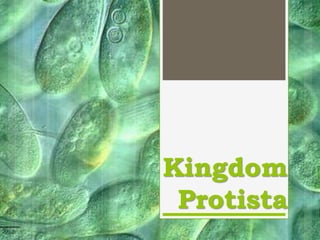
Kingdom Protista
- 2. All single-celled organisms are placed under the Kingdom Protista. The term Protista was first used by Ernst Haeckel in the year 1886. This kingdom forms a link between other kingdoms of plants, animals and fungi. Protists represent an important step in early evolution. The first protists evolved probably 1.7 billion years ago. Many protists like algae are the primary producers in the aquatic ecosystem, some protists are responsible for serious human diseases like malaria and sleeping sickness.
- 3. Definition Kingdom Protista is a diverse group of eukaryotic organisms. Protists are unicellular, some are colonial or multicellular, they do not have specialized tissue organization. The simple cellular organization distinguishes the protists from other eukaryotes. The cell body of the protists contain have a nucleus which is well defined and membrane bound organelles. Some have flagella or cilia for locomotion. Reproduction in protists is both asexual and sexual. They live in any environment that contains water. Characteristics They are simple eukaryotic organisms. Most of the organisms are unicellular, some are colonial and some are multicellular like algae. Most of the protists live in water, some in moist soil or even the body of human and plants. They have mitochondria for cellular respiration and some have chloroplasts for photosynthesis. Nuclei of protists contain multiple DNA strands, the number of nucleotides are significantly less than complex eukaryotes. Movement is often by flagella or cilia. Respiration - cellular respiration is primarily aerobic process, but some living in mud below ponds or in digestive tracts of animals are strict facultative anaerobes. Nutrition - they can be both hetereotrophic or autotrophic. Reproduction - some species have complex life cycle involving multiple organisms. They can reproduce by mitosis and some are capable of meiosis for sexual reproduction. Some protists are pathogens of both animals and plants. Example: Plasmodium falciparum causes malaria in humans. Protists are major component of plankton.
- 4. Classification Protozoans Animal-like single- organism Phylum Sarcodina The movement in sarcodinians is by extending lobes of cytoplasm known as pseudopodia. The pseudopodia is used for movement and feeding. During the formation of the pseudopodia the cytoplasm streams into the lobe causing the lobe to 'ooze' and grow. Because of this the pseudopodians have a 'blob like appearance. Phylum Mastigophora These protozoans move with the help of flagella. Most of them are parasitic. Many flagellates are seen in the intestine of humans, in termites and other animals, some flagellates are harmful. Phylum Ciliophora Protozoans of this phylum move with hair like structures called cilia. The cilia stick out of their cells. The movement of cilia is paddle like, it sways back and forth for movement and fast beating of the cilia causes movement of the organism. The cilia is also used to sweep food particles into the organism. Phylum Sporozoa All members of this phylum are non-motile and parasitic. They forms spores and hence the name sporozoa. They lack locomotory structures and they are carried in their hosts by their body fluids. Many sporozoans causes serious diseases in humans.
- 5. Classification Algaeplant-like single or multi-celled organisms Phylum Chlorophyta (Green Algae) The green algae include unicellular and multicellular algae. They are mostly fresh water. Body is sheet-like thallus. They have cell walls made of cellulose and pectin. Food is reserve starch which is stored in pyrenoids. Phylum Rhodophyta (Red Algae) Red algae are mostly large and multicellular. They grow in oceans. Carragean and agar are glue-like substances in red- algae. Agar is used as a medium used for growing bacteria and other organisms under laboratory conditions. Agar is also used to make gelatin capsules. and a base for cosmetics. Carragean is used as a stabilizer and thickener in dairy products. It is also used to give toothpaste its creamy texture. Phylum Phaeophyta (Brown Algae) Brown algae are multicellular. They grow on rocks in shallow water of the sea. Large brown algae are called kelps. Kelps may grow densely in the sea and form kelp forests. They form important food sources for fish and invertebrates. The brown algae growing on rocks are known as rockweed. Phylum Chrysophyta (Golden algae) 'Chryso' means 'color of gold'. There are three types of golden-algae: yellow-green algae, golden brown algae, diatoms. Diatoms are the most abundant and are found in seawater and freshwater habitats. Phylum Pyrrophyta (Fire Algae) It contains of species of one-celled algae called dinoflagellate which means 'spinning swimmers'. They store food in the form of starch and oils. The red color is due to chlorophyll a and c and xanthophylls. These organisms have ability of bioluminescence.